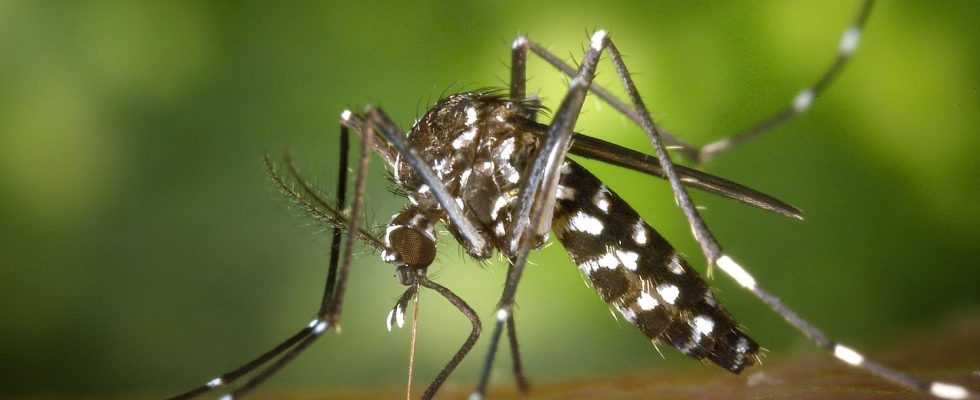In the south of France, “the larvae are starting to develop slowly,” observes Grégory L’Ambert, medical entomologist, head of the tiger mosquito and public health center at EID Mediterranean (Interdepartmental agreement for mosquito control on the Mediterranean coast) based in Montpellier (Hérault). We will have to wait another “two to three weeks” for this to be the case for the regions further north.
“But whether you have larvae starting to develop in your water collectors, or it is imminent, mid-April is the right time to start the fight against tiger mosquitoes,” says the specialist. Here is what you need to know about the development of the species, and the right actions to adopt to avoid its proliferation.
How does the tiger mosquito develop?
This invasive species that appeared in France just twenty years ago, in 2004, first via the south-east of the country, needs two factors to develop, recalls Grégory L’Ambert. After a winter diapause (a sort of hibernation) in the egg state, the specimens will need “an extension of the photoperiod (day length), which we find from the month of April, and a temperature of a minimum of 15°C, to allow the eggs to hatch. From there, the development of the larvae is completely “temperature-dependent”: the warmer it is, the faster it is.”
Then, “we begin to see the first tiger mosquitoes fly at the end of April in the places where it is hottest, and it increases in strength during the month of May until summer. This is why the anti-dengue fever and anti-chikungunya [virus transmis à l’homme via le moustique-tigre] will only be implemented from May 1st.
In what environment does it proliferate?
The particularity of the tiger mosquito “is that it lives as close as possible to humans, unlike other species”, analyzes Grégory L’Ambert. “It grows in the city, in your garden, on your terrace. » It proliferates in very small concentrations of water, “largely in rainwater collectors, but also in flower box cups, watering cans, tarpaulins lying around, poorly washed gutters, terraces on plot…”, lists Pierre Ouallet, deputy mayor of Bègles (Gironde) in charge of ecological transition.
The tiger mosquito was identified for the first time in the metropolis of Bordeaux in 2014, and was recorded in Bègles in 2015. “Awareness measures began around 2019-2020,” recalls Pierre Ouallet. Today, people know quite well the measures to take, but they still need to be thought about, which is why teaching requires repetition. »
What are the effective measures to combat the tiger mosquito?
“The tiger mosquito absolutely needs water to develop, this is also its weakness,” continues Grégory L’Ambert. It is enough to empty these water receptacles where it reproduces once a week, to prevent its proliferation, the difficulty being finding all these small containers. »And so this is the right time to do it. You should also know that the tiger mosquito, unlike other species, does not move around much. “A hundred meters on average, 200 meters maximum, so if you eliminate water from your immediate environment, the results will be obvious,” assures the entomologist. “Everything else can only be complementary,” he adds. You can put all the traps you want, if you don’t remove the water it won’t do any good. »
How many eggs does a female lay?
The female lays “between 80 and 150 eggs each time,” estimates Grégory L’Ambert. “During its life, which lasts between two and four weeks, it repeats the same cycle up to six times: it stings to gain strength and lays between 48 hours and 72 hours later, it waits 24 hours, and stings again. She can therefore lay around 800 eggs in her life, and produce 400 females… These are parasites which invade the environment very quickly, which is why we must take matters in hand from the start. » You should also know that only the female bites, “the male only feeds on sweet things (nectar, ripe fruit, etc.)”. This is why it is advisable to collect ripe fruits from the ground.
Is vegetation a factor in the development of the tiger mosquito?
We sometimes hear that vegetation should also be limited to prevent the proliferation of the tiger mosquito. A factor to be qualified according to the entomologist. “In summer, when it is very hot and the weather is very dry, the tiger mosquito will actually need shade and humidity, which it will find in the vegetation. So, a lush garden creates a favorable environment for adult mosquitoes to survive the day. Now, I’m not saying that you shouldn’t have vegetation and concrete your entire garden, otherwise you’re going to have other problems. We really need to put this into perspective, especially since it depends on the region, and in the end, trimming hedges will never be as decisive as emptying your water points. »
Will this winter’s heavy rains favor the tiger mosquito this year?
Not necessarily. “It is true that we had a winter and early spring favorable for the development of the mosquito, but for the tiger mosquito, it is a little different, since it certainly needs water to develop, but at the right time, that is to say now. And too much water is not favorable for this species either, because it will “wash out” the watering can, the cup where it proliferates, and the larvae with it. On the other hand, if it rains once a week between now and August, it could be very stinging. »

